KANSAS CITY, Mo. — The average lead time for a tornado warning is 10-15 minutes. So if you heard tornado sirens, is that enough time for you to get somewhere safe?
Not all homes have basements, not all community spaces have shelters, and as we move into the warm season, many of us find ourselves outside exploring new areas.
To make it easier to find a safe place when severe weather strikes, Dr. Craig Ceecee created a tool. But as you look at the map for the Kansas City Area Ceecee says, you'll notice some holes.
"There are definitely holes I’ve noticed, across much of the Metro, including on the Kansas side. But also on the north side of the metro there are some holes. Even one downtown would be pretty useful if there is no way to like retrofit a parking garage," Ceecee said. "There are some spots that have coverage. There’s definitely room for improvement, but it’s certainly not the worst case, there are many metro areas that have zero."

So looking at this map I thought to myself, how does this map hold up when we compare where destructive (EF4 & EF5) tornadoes have hit? The results honestly shocked me a bit.
Before we dive into that, keep in mind EF4 & EF5 tornadoes are very rare, they make up less than 1% of all tornadoes across the United States. Doing some quick math it comes out that the US averages roughly 8 EF4 tornadoes a year and less than 1 EF5 per year.
The last EF4 was On March 24, 2023, in Mississippi. 21 people were killed in during a severe weather outbreak where two EF3's with a deadly EF4 in Rolling Fork, MS. The last EF5 was May 20, 2013 in Moore, Oklahoma. 25 people were killed that day with over 200 injuries reported. Over 1,150 homes were destroyed, resulting in an estimated $2 billion in damages in the area.
The most common tornado rating across the US is EF0 and EF1, making up about 80% of all tornadoes.
1950-2021 Tornado Count
- EF0: 31,980
- EF1: 22,885
- EF2: 9,517
- EF3: 2,536
- EF4: 581
- EF5: 59
The last EF 4 in Kansas City was Linwood in 2019, it produced 18 injuries and thankfully zero fatalities. The last F5 in Kansas City was the only F5 in our area, the Ruskin Heights Tornado in 1957. According to the National Weather Service, the period of May 19-26, 1957 has been recognized as one of the most active period for tornadoes with 50 tornadoes reported across the Midwest.

Most wind speeds within a tornado are estimated after damage assessments are done using the Enhances Fujita Scale. According to the National Weather Service, "The EF Scale incorporates 28 damage indicators (DIs) such as building type, structures, and trees. For each damage indicator, there are 8 degrees of damage (DOD) ranging from the beginning of visible damage to complete destruction of the damage indicator." So when it comes down to it, tornadoes are really rated based on the damage that they create.

But EF0 to EF5, Wyndotte County Unified Government Emergency Manager, Matt May treats all tornado threats the same. On April 25, 2009, the National Weather Service confirmed a tornado on the ground just to the southwest of the racetrack.
Luckily the stands were already empty as NASCAR officials had suspended the race 30 minutes prior due to thunderstorm activity. But with no FEMA shelter nearby, what’s the plan if there is a tornado threat? May explains,
"The stands themselves don’t provide a lot of shelter and so we try to give them enough lead time to get out of the stands and into their cars... If you are in your car and tornado is coming they recommend turning the ignition on because it makes sure the airbags are activated, because some cars do not have airbags activated when it’s not running," May said. "We tell them to turn the ignition on, stay in the car, you might get rolled, you might not, but you are going to be in far better shape than if you are out in the open.”
NASCAR to shopping, the Legends area in Wyandotte County holds vulnerability as an outdoor space. But it has been a while since we’ve seen a destructive tornado move toward that area. The most recent was only seven years ago with the Linwood tornado.

Just south of the Kansas river, another heavily populated area sits without any FEMA shelters. But for Johnson County, it has been 60-70 years since they’ve seen a destructive tornado.
Claire Canaan is the Assistant Director with Community Preparedness for Johnson County and shares these tips,
“A shelter is just one piece of that preparedness puzzle. And what we always want to drive home to our residents and visitors within Johnson County, is to have a plan. Have that plan before disaster strikes," Canaan said. "Before you are sitting in your office watching severe weather roll in. Identify in your home, your place of business or places you frequent, if you have children’s schools in Johnson County, knowing that if you are in that place when severe weather is imminent or it’s happening, and there is a tornado warning issued. Where can you go seek shelter.”
And don't forget it is just as important to practice that plan. Build some muscle memory and talk to your kids about what to do when a tornado watch or warning is issued. Kansas City is still a member of tornado alley. With the state of Kansas averaging 96 tornadoes each year and Missouri 32.





